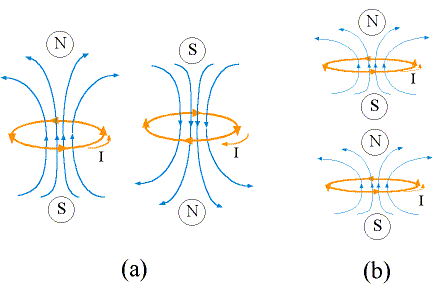Something which either has field lines emanating from it or moving in towards it is called a pole. If we have just one pole, we say that we have a monopole. If we have two poles, then we say that we have a dipole. A grouping of four poles is called a quadrupole. (We are only interested in numbers of poles of the form 2n where n = 0, 1, 2, ....) Our electric charges are evidently electric monopoles, since they either have electric field lines moving away from them or in towards them. However, the magnetic current loop has both magnetic field lines moving out of the loop’s center and into the loop’s center. We say that the current loop is a magnetic dipole. (We would get a very similar field pattern if we placed a positive electric charge just above a negative electric charge. This is an electric dipole. See if you can sketch out the electric field lines for such a combination of charge and show that it is just like that for the magnetic field lines around a current loop.)
The two poles of the current loop are called the magnetic north pole and the magnetic south pole. The magnetic north pole is the pole from which the magnetic field lines emanate (just like the positive charge in the electric case), and the magnetic south pole is the pole toward which the magnetic field lines move (just like the negative charge in the electric case). The two poles of the current loop are shown in Fig. 17.7 in the previous section. (These poles are not points or objects like the electric charges, but are rather simply regions associated with the center of a current loop.)
Just as opposite charges attract and like charges repel, likewise opposite poles attract and like poles repel. The tendency for current loops is therefore either for neighboring loops to be side-by-side and “anti-aligned” as shown in Fig. 17.8 (a), or to be aligned in a row, as shown in Fig. 17.8 (b).
|
A few words are in order at this point concerning the earth’s magnetic field. In particular, much confusion abounds about the earth’s north and south poles. Let’s dispel of this confusion (at least for you!) once and for all.
There is a difference between the earth’s magnetic north pole and the earth’s geographic north pole. When we speak of the earth’s north pole, we tend to mean the pole which is at the geographic north of the earth. Why is geographic north called “north”? It was discovered long ago that stones having special properties, called lodestones, tended to point in the same direction when suspended from a string. The lodestones were permanent magnets (see the next section). The north magnetic pole of the lodestone always pointed in the same direction because it was always attracted to the south magnetic pole of the earth, which has its own magnetic field (probably due to the circulation of metals within the earth’s molten core). Likewise, the south magnetic pole of the lodestone was always attracted toward the earth’s magnetic north pole. Geographic north was called north because that was the direction pointed toward by the north pole end of the lodestone. (It was not understood at the time that the earth had its own magnetic field. Indeed, the concept of magnetic field itself was not understood at the time!)
A compass is a modern lodestone. Instead of suspending a magnetic stone from a string, we balance a magnetic arrow on the tip of a needle (or suspend it in a fluid in more expensive compasses). The point-end of the arrow is the magnetic north pole of the metal making up the arrow. It is therefore attracted toward the earth’s magnetic south pole, which we call the geographic north pole since the arrow’s north pole points us in that direction. (OK—so much for dispelling of confusion...!)
When dealing with compasses and magnets, it is always very important to keep in mind that the compass arrow-tip is the north magnetic pole of the compass needle. It will always be attracted to the south magnetic pole of a magnet. If your compass points toward a given end of a magnet, then that end must be the south magnetic pole of the magnet.
